When I do output measurements on flashlights or emitters it is the oldfashioned way: with ceiling bounce lux-measurements. For relative output within a measurement series of one flashlight or emitter it works very well. To obtain true output values it is less suitable (the lux-reading is somewhat angle-dependent, therefore a bit sensitive for beam patterns, especially the results for zoomies I do not trust fully) but I believe it works for my personal goal: getting within 5% of reality, I never claim to be more precise than that for absolute numbers.
Like many I am tempted to get my measurements more precise. But that means a lot of investment in time and money. I could purchase a Fluke meter to get the current measurements really precise (500 euro), a really decent power supply for 20A (500 euro), build a integrating sphere (many hobby-hours), get myself a good and calibrated luxmeter that unlike the cheap ones really follows the eye sensitivity curve (540 euro), and obtain a calibrated reference light source for calibration of the sphere (who knows how expensive that is?). I may invest in a new power supply one of these days, but that will probably be it for this year.
For calibration of my ceiling bounce measurements my make-do reference light sources are two flashlights, a Sunwayman D40A (980lm at start according to the manual) and a Thrunite Archer1A (178lm on a fresh alkaline according to the manual), the actual copies that I have of these flashlights do not necessarily have precise those values but at least if I measure them, relative to each other the values match the official specs. I have to say that for my standard set-up I do check the calibration regularly, but the conversion value from lux to lumen measures the same every time, so the set-up is quite robust.
For the Archer I use up a new Duracel battery for every measurement that I want to calibrate, and both the Archer and the D40A suffer some output drop during runtime, not much, they are both well stabilised, but it is there. These flashlights are ok, but not ideal.
So of the improvements that were possible the easiest one was to make myself a reference lightsource with constant known output. Officially that is supposed to be a tungsten lamp connected to a very well stabilised power supply, but that is expensive, difficult and no fun, it had to be a flashlight. A good heatsinked underdriven lineair regulated flashlight should do the job. I made one a few months ago (Ultrafire K10 host, cool white XM-L2 on Sinkpad soldered to brass pill, 2x7135 one-mode driver, Efest 14500 battery) and yesterday I made a second one (Convoy M2, XM-L2 5B1 80CRI on Sinkpad soldered to brass pill, 4x7135 NANJG 101-AK 3mode driver, 18650 battery).
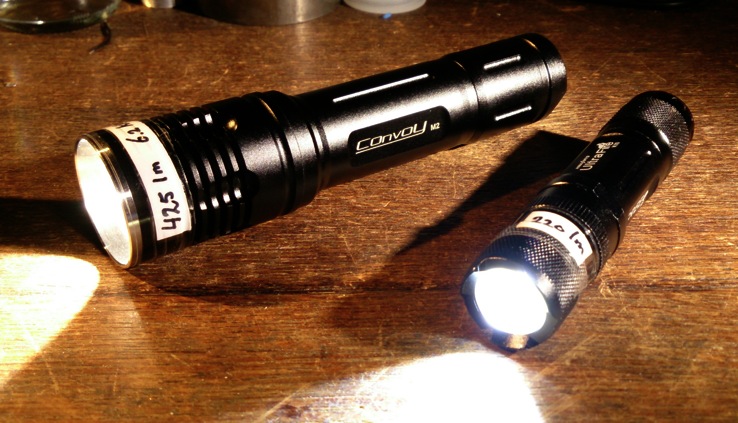
And indeed, they give very nice stable outputs, more stable than the D40A or Archer, but the output is not completely flat unfortunately. I did some runtime tests on the modded Convoy M2, and on the Sunwayman D40A and the Trunite Archer 1A (not on the Ultrafire K10, but it looks like it behaves quite like the Convoy). The Convoy I did twice, first a 40 minutes runtime starting with a full NCR18650B (2200mAh) battery, 20 minutes switched-off for cooldown, then a 20 minutes runtime on the now half empty battery. Here are the results:
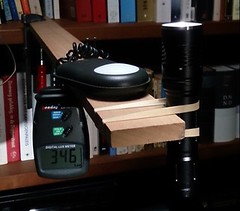

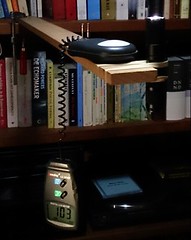
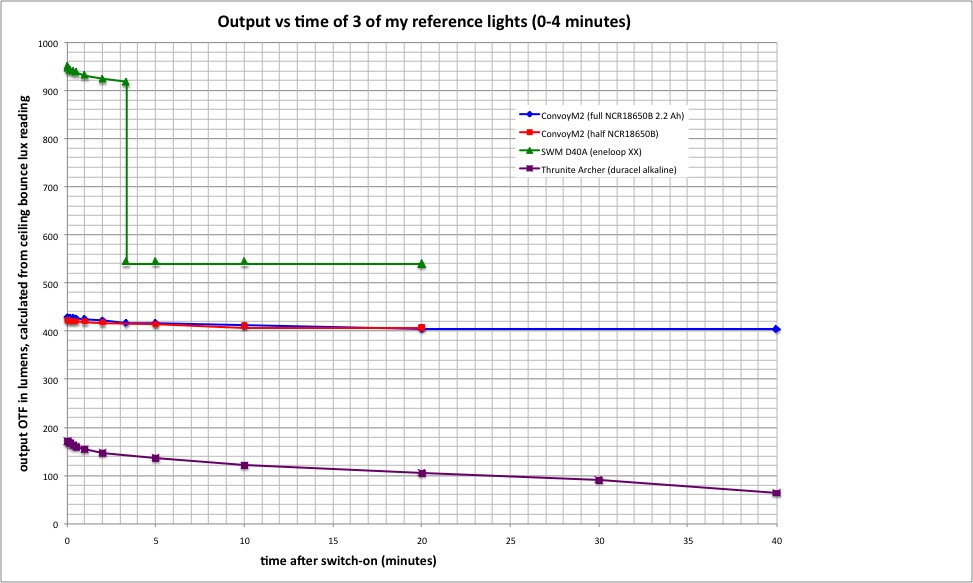
As you can see, the output of the Convoy is more constant than both the SWM on Turbo and the Thrunite. But after the temperature step-down to high, after 3.5 minutes, the output of the SWM was really constant, perhaps if the SWM was started on high it is even more constant than the Convoy even in the first minutes, I will test that sometime. EDIT 30/3/2014: it is in post #3
For the use as a reference light, the first minute is the most interesting (you do not want to wait half an hour for the reference light to be ready for calibration), so here's the first 4 minutes of the graph stretched:
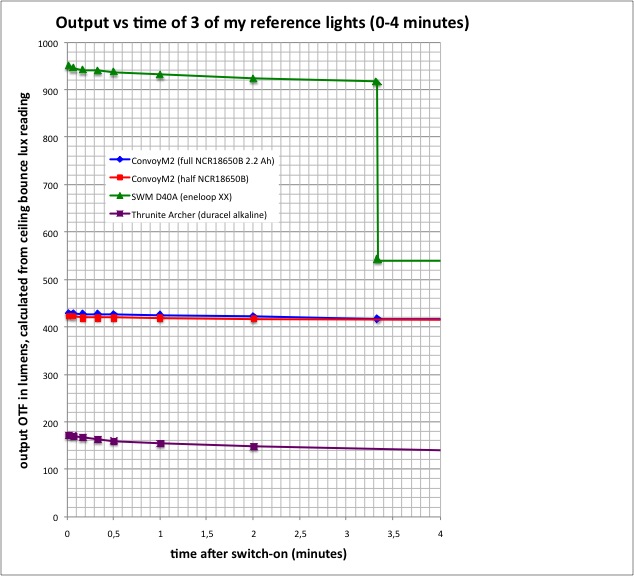
So in the first minute the SWM and the Convoy stay constant within my 5% , the Archer does that only within the first 20 seconds. But usually I do the calibration between 10 and 30 seconds after switch-on, the output drops are then: SWM D40A: 0.42%, ConvoyM2: 0.3%, Thrunite Archer: still 4.3%.
Although the 7135 chips should deliver a constant current regardless of the input voltage, there is a slight difference between starting with a full battery and with a half full battery. The graph zoomed-in between 400 and 430 lumen (blue=full battery, red=half battery):
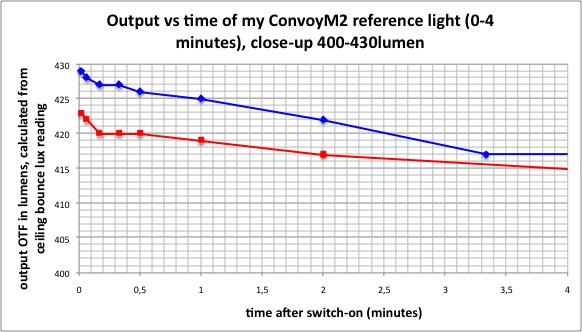
After 4 minutes the two lines as good as overlap again. This reference light works even a bit better if a not completely full battery is used.
Note that both the Sunwayman and the Archer in these tests have a slightly lower output than spec'ed, that is because of the way they were fixed next to the lux-meter sensor: the hotspot is not projected straight above the sensor but a bit to the side. For normal checking calibration I project them by hand, on the right spot.
I'm happy with the new lights, the Convoy probably even makes a useful (but not 'wow' of course) camping light: it is 4000K 80CRI, it is efficient: 74 OTF-lm/W, it has 425 lumen on high with 6.2klux@1meter throw, runtime on a 3400mAh battery should be 2.5 hours, on low I measure 22 lumen (50 hours), on med 132 lumen (8 hours).
Oh, and while I was at making reference lights, I have asked a company that does light calibrations (lichtconsult.nl) what it costs to measure the true output of my two reference lights for me in their sphere, say after 10, 20 and 60 seconds. They were really nice, answered that they could do one measurement for me with an official certificate and email the two other numbers off-the-record for free as well. It was 230 euro's for the first flashlight and 40 euro's for the second one. Hmm, I think I will stick to my usual 'just about' way for a while ;-)
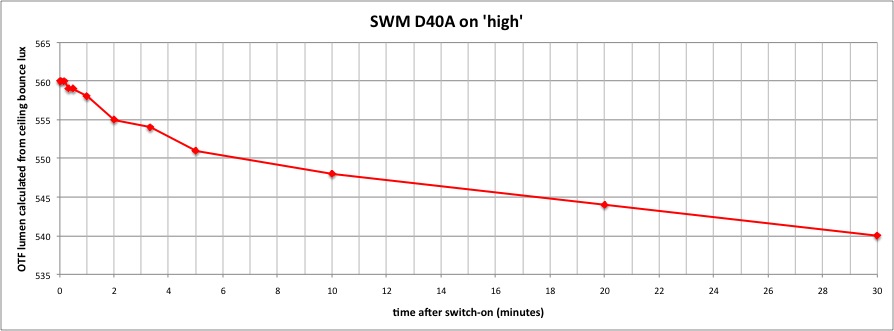
 , I suspect that the internals of many if not all common cheap chinese luxmeters are exactly the same, at least the same detector, the same colour filter in front of it. But already the shape of the diffuser can make the detector react differently on light coming from an angle, making the beam-shape a factor involved.
, I suspect that the internals of many if not all common cheap chinese luxmeters are exactly the same, at least the same detector, the same colour filter in front of it. But already the shape of the diffuser can make the detector react differently on light coming from an angle, making the beam-shape a factor involved.